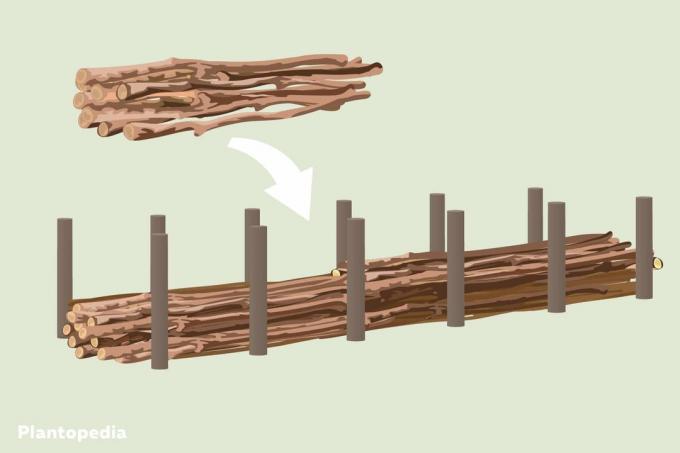
Creating a Benje hedge is easy and doesn't require too much material. If there is enough brushwood in the garden, it is practically free. Just the layering requires some work.
To the point
- Benje hedges consist of brushwood and prunings of different types of wood
- fresh brushwood can turn out
- Bushes and trees then grow on their own
- Animals and plants find shelter
- other garden waste can also be processed
Table of contents
- Definition of a Benje hedge
- Create Benje hedge
- The right material
- Necessary tool
- Creating a Benje hedge – instructions
- Interesting facts about the Benje hedge
- Questions about the deadwood hedge
Definition of a Benje hedge
A hedge made of stacked brushwood is called a Benje hedge or deadwood hedge. Posts are used for stabilization and are driven into the ground at regular intervals. In between, the existing material is loosely piled up. Over time, the deadwood hedge develops into a living hedge with a variety of plant and animal species.

Create Benje hedge
Building such a hedge or fence does not require a lot of effort and materials. Much of it is usually already available in your own garden or can be purchased cheaply or free of charge through advertisements on the Internet or from garden neighbors.
The right material
In principle, any wood is suitable, but it still makes sense to pay attention to some of the characteristics of the different types. Since the Benje hedge should not remain dead, it is correct to use wood that can still sprout and grow. Therefore they are suitable:
- different types of pasture
- hazelnut
Blackberries also grow very quickly and well from cut vines. Unfortunately wild blackberries quickly overgrow the entire hedge and are therefore undesirable.

Fruit trees, other deciduous trees and coniferous wood are also suitable. The brushwood should be approximately the same length. Tree stumps and thicker branches can also be used to loosen things up. Even green waste and leaves can be stored in the hedge.
You can use thick, straight branches as posts; it is then unnecessary to buy extra branches for them.
Necessary tool
- possibly an earth auger (only for heavy, compacted soils)
- hammer
- secateurs
- Pruning shears or saw
Creating a Benje hedge – instructions
- Determine the length, width and height of the hedge
- Height should not exceed 150 cm, otherwise it will be difficult to pile up and become unstable
- Determine the post distance based on the longest branches or twigs
- Drive posts into the ground at the appropriate distances
- Layer branches and twigs between the posts
- Loosely layer thicker and longer material at the bottom to form cavities
- Weave long branches between the posts
- Trim any protruding branches with pruning shears or a saw


Interesting facts about the Benje hedge
- Even if we talk about a deadwood hedge, the wood does not necessarily have to be dead
- Fresh wood cuttings are just as suitable as older ones
- Hedge collapses over time, that's intentional
- the bottom layer becomes the hummus layer
- Wind and animals bring wild seeds into the hedge
- These germinate and enrich the hedge with different plant species
- Brushwood can be piled up again later
- Do not compact the hedge, otherwise animals in cavities are at risk
- Benje hedge only works well in conjunction with a natural garden
- otherwise the hedge actually remains mostly dead

Questions about the deadwood hedge
Overall, a dead wood hedge requires little work, doesn't take up much space, offers good privacy and is suitable as protection for various animal species. In contrast to a planted hedge, for example, there is no need to water and no undergrowth or weeds need to be cut out.
These include various species of insects whose larvae feed on dead wood or use the hedge as a hiding place. On the other hand, over time mammals also appear, for example Hedgehog or mice. Even individual reptiles, for example Lizards or Grass snakes can use the hedge. A deadwood hedge is also very important for birds, which can nest in the hedge if there is sufficient density and width.
The best thing for the Benje hedge is if it is left alone for most of the year. Only then can it develop independently and plants and animals find a place that offers them living space. Maintaining a deadwood hedge doesn't require a lot of work. If individual bushes sprout and grow successfully, they may need to be shortened on the sides from time to time so that the hedge does not become too wide. It may also be necessary to cut out certain plants that develop faster than the hedge itself, for example: Nettle or the blackberry.

